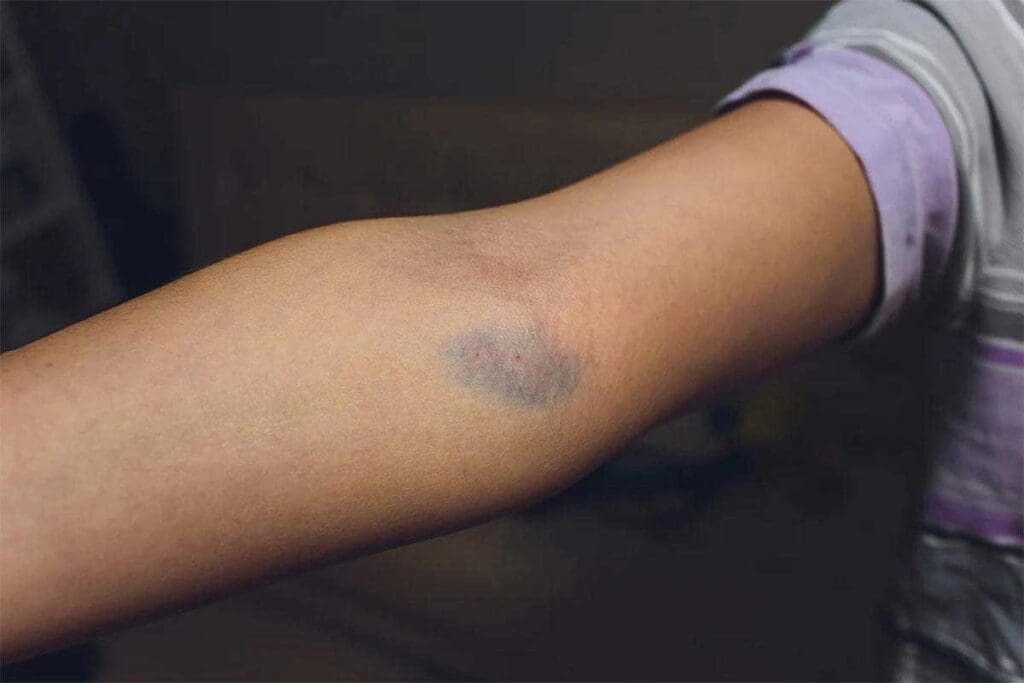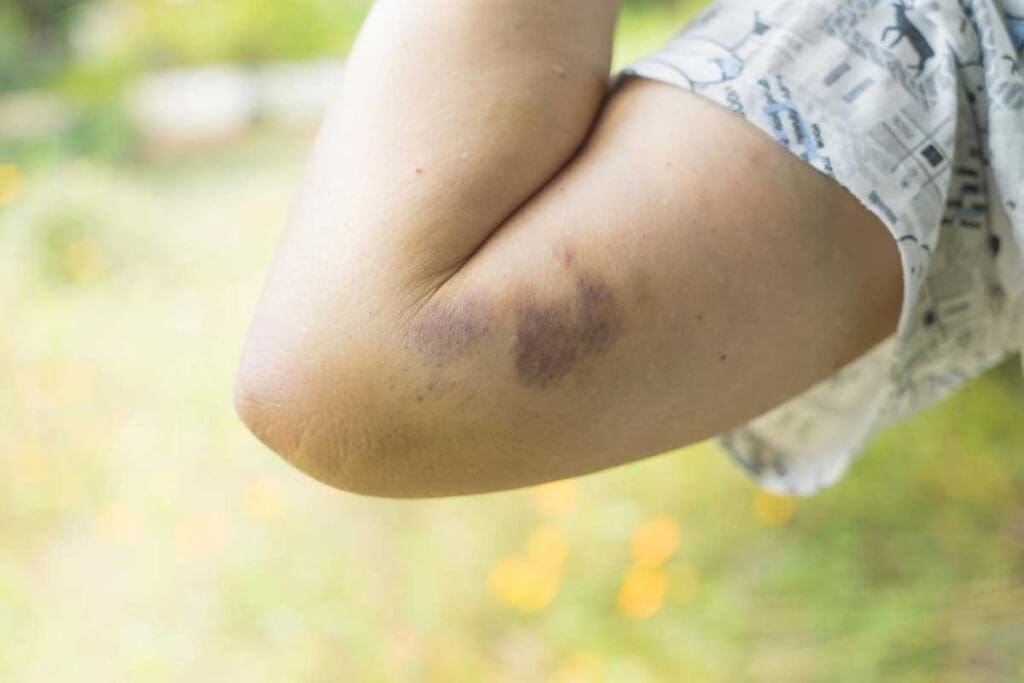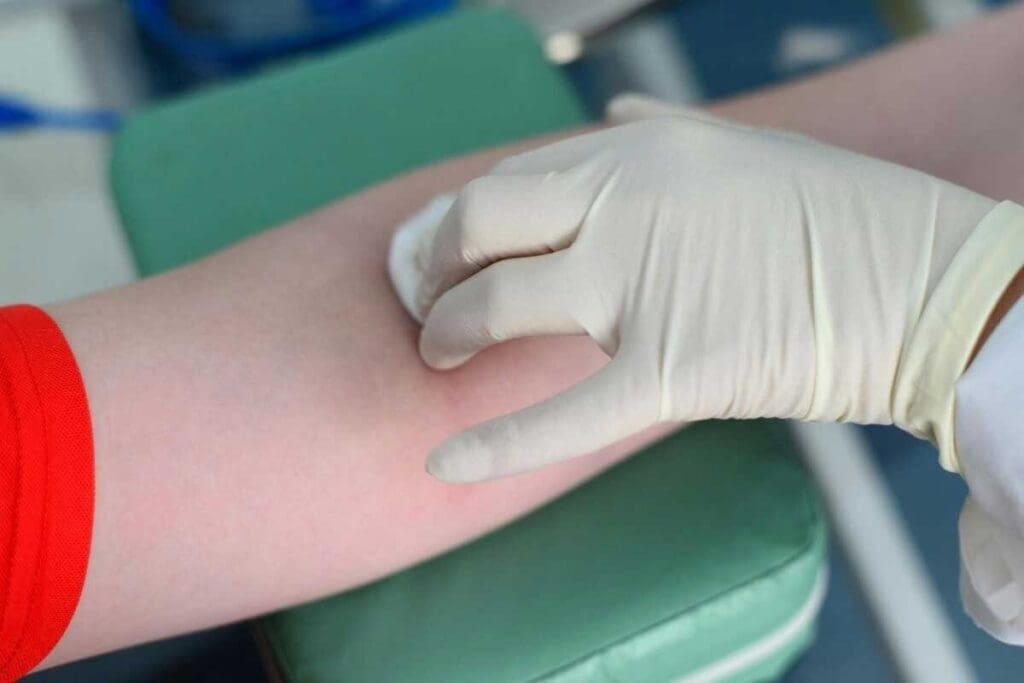Last Updated on November 17, 2025 by Ugurkan Demir

A blood clot in the arm is a serious health issue. It’s important to spot the early signs to get medical help fast. We’ve gathered arm blood clot images to show you symptoms like swelling, color changes, pain, and warmth in your upper arm. View arm blood clot images and pictures to recognize early symptoms, warning signs, and possible risks.
Medical experts say a blood clot in the arm can be linked to health problems or medical devices like catheters or pacemakers. Knowing these risks and the visual signs can help you get medical care when you need it.

It’s important to know why blood clots form in the arm. These clots can happen for many reasons, like how we live, our genes, and health issues.
Deep vein thrombosis (DVT) in the upper arm is not common. It often happens after doing hard or repetitive arm work, like lifting weights or rowing. DVT can also form when blood flow is blocked, causing a clot.
Some common risk factors include:
Seeing blood clots in the arm early is key. Spotting signs and symptoms can help a lot in treatment.
Some key visual indicators include:
Knowing these signs and risk factors helps people get help fast. This can stop serious problems.

It’s vital to spot warning signs in arm blood clot images early. This can lead to quick medical help. We’ll look at the main signs that show a blood clot in the arm.
Swelling and edema are key signs of a blood clot in the arm. Arm blood clot images often show swelling in the affected limb.
To spot swelling, look for:
Discoloration is another important warning sign in blood clot arm photos. The area may look red, blue, or purple because of the clot.
| Discoloration Type | Description |
| Redness | Inflammation around the clot |
| Bluish discoloration | Impaired blood flow |
| Purplish hue | Pooling of blood |
Pain and warmth are also signs of a blood clot. Patients might feel pain or tenderness in the arm. The area may also feel warm.
Looking at pictures of arm blood clots is key to spotting superficial vein thrombosis. This condition shows inflammation and clotting in a vein close to the skin’s surface. It has clear signs that can be seen.
One main sign of superficial vein thrombosis is reddened vein tracks in photos. This redness comes from inflammation caused by the clot. The vein might look swollen, feel warm, and hurt when touched. Sometimes, the redness spreads beyond the clot area.
Key characteristics to look for include:
It can be hard to tell superficial vein thrombosis from normal veins. Some veins are always visible, like in people with fair skin or low body fat. But, veins with thrombosis are usually more swollen and show clear signs of inflammation.
To spot superficial vein thrombosis, look for these differences:
By carefully looking at blood clot pictures in arm and knowing these signs, doctors and people can tell superficial vein thrombosis apart from normal veins.
Blood clots in the deep veins of the arm are serious and can be deadly if not caught early. These clots, known as Deep Vein Thrombosis (DVT), form in the deep veins, often in the upper arm. Seeing the signs of DVT through pictures is key to quick detection and treatment.
DVT in the upper arm shows several signs. Swelling, discoloration, and warmth in the affected arm are common. Swelling is a major symptom, often with pain or tenderness. The skin may look red or discolored because of inflammation.
Spotting these signs early is vital, as untreated DVT can cause serious problems.
Images of blood clots in the arm, including the right arm, help diagnose DVT. Looking at these pictures can show signs like swelling and discoloration. By comparing normal and DVT-affected arm images, doctors can diagnose and treat better.
Using blood clot arm pictures helps us spot DVT signs early. This leads to better treatment for patients with Deep Vein Thrombosis.
Visual guides for forearm blood clot in arm pictures help in recognizing warning signs. These images are key for spotting below-elbow clot presentations and visible vein changes in the forearm.
Blood clots in the forearm show through swelling, pain, and warmth. Spotting these signs early is key for effective treatment.
Medical experts say, “Early detection of deep vein thrombosis (DVT) in the forearm can greatly improve treatment outcomes.”
“Prompt medical attention is vital for patients showing symptoms of forearm DVT.”
Visible vein changes are a big sign of a blood clot in the forearm. These changes might include discoloration, swelling, or a cord-like structure along the vein.
| Symptom | Description |
| Discoloration | Redness or bluish discoloration around the affected vein |
| Swelling | Localized swelling in the forearm |
| Palpable Vein | A cord-like structure felt along the vein |
By understanding and recognizing these visual cues, people can get medical help quickly. This can help prevent serious complications.
Looking at elbow blood clot in arm pictures is important. You need to spot key signs that show a health problem. Blood clots in the elbow can be serious because of the joint’s complex structure and the risk of mobility issues.
One key sign is blood pooling at joint areas. This happens when blood gathers around the elbow, causing swelling. Blood pooling is a big clue of a blood clot, along with pain or warmth.
Blood pooling around the elbow shows as swelling or discoloration. In pictures, it looks like a darker or more noticeable area around the elbow. It’s important to compare both arms to spot any differences.
Another important sign is tenderness and redness at the elbow crease. The crease can get inflamed or tender if there’s a blood clot. Pictures might show redness or a change in skin texture here.
In some cases, elbow blood clot in arm pictures may show warmth or a slight temperature increase. This is due to inflammation from the clot. It’s key to notice these small changes, as they can point to a serious issue.
By carefully looking at elbow blood clot in arm pictures, you can understand your condition better. If you see these signs, it’s best to see a doctor for a proper diagnosis and treatment plan.
Images are key in treating arm blood clots. Advanced imaging helps doctors diagnose and manage these clots well.
Ultrasound is a top choice for spotting arm blood clots. It’s non-invasive and very sensitive. Ultrasound is great for upper extremity clots, showing signs like vein swelling and clot material.
CT scans give detailed views of arm blood clots. They’re good for tricky cases or when ultrasound isn’t clear. CT scans show clot details that help plan treatment.
MRI is also valuable for finding arm blood clots. It shows soft tissues well and checks blood flow. MRI is best when ultrasound or CT isn’t clear or when more tissue info is needed.
| Imaging Modality | Sensitivity for Clot Detection | Advantages | Limitations |
| Ultrasound | High | Non-invasive, portable, no radiation | Operator-dependent, limited depth penetration |
| CT Scan | High | High-resolution images, fast acquisition | Radiation exposure, contrast required |
| MRI | High | Excellent soft tissue contrast, no radiation | Expensive, claustrophobia, contraindicated with certain implants |
Using these imaging methods helps doctors accurately diagnose and treat arm blood clots. The right choice depends on the patient’s situation and what’s available.
When looking at arm blood clot images, it’s key to tell real blood clots from other similar conditions. Getting the right diagnosis is vital for the right treatment. Pictures can help doctors and patients spot the right condition.
Cellulitis, a skin infection, can look like blood clots in arm pictures. Both can cause swelling and redness. But cellulitis spreads out more and feels warmer. Blood clots are more focused and painful.
Cellulitis covers a bigger area and has deeper redness. Blood clots show symptoms along veins, seen clearly in images of blood clot in arm.
Muscle injuries can look like blood clots with pain and swelling. But muscle injuries come from accidents or too much use. They show bruises or tenderness not linked to veins. Look for specific signs in blood clot arm photos.
Muscle injuries don’t have the same vein-related symptoms as blood clots. By checking images of blood clot in arm, doctors can tell them apart.
Lymphedema, a swelling issue, can look like blood clots. But lymphedema swells the whole limb and doesn’t hurt or feel warm. It’s important to look at pictures of blood clots in arm carefully.
Lymphedema swells the whole limb, not just a vein. It’s linked to surgery, radiation, or infections. By comparing images of blood clot in arm with symptoms, doctors can find the right treatment.
Images of blood clots in the arm help patients take charge of their health. By learning to recognize signs and symptoms, patients can understand their condition better. They also know when to get medical help.
Patients can check themselves at home using pictures of blood clots in arms. Look for swelling, redness, or discoloration in the arm. Also, feel for warm or tender spots, or red or discolored areas, which might show a blood clot.
We’ve made a table to help with self-checks for blood clots in the arm:
| Signs to Look For | Description |
| Swelling | Noticeable swelling in one arm compared to the other |
| Redness or Discoloration | Areas that are red, purple, or discolored |
| Warmth or Tenderness | Warm or tender spots when touched |
| Pain | Unexplained pain or discomfort in the arm |
If you notice any unusual signs or symptoms, see your doctor. Showing doctors pictures of blood clots in arms can help with diagnosis and treatment. Tell them all about your symptoms, including when they started.
Using images of blood clots in arms for education and self-checks can lead to early detection and treatment. This approach helps patients take control of their health and leads to better outcomes.
We stress the need to use visual awareness with arm blood clot images for early help. Spotting warning signs in these images helps people get medical care fast. This can lower the chance of serious problems and better health results.
Spotting blood clots early and treating them can stop big health issues. Images of arm blood clots help people see problems and talk to doctors quickly.
Using arm blood clot images to check on yourself and share with doctors is a smart health move. Being aware of blood clot signs is vital for early action. We urge everyone to learn about these signs.
Symptoms include swelling, edema, and discoloration. You might also feel pain and warmth. Look for reddened vein tracks as a visual sign.
Look for swelling, discoloration, and reddened vein tracks in arm images. Comparing these with your symptoms can help spot warning signs.
Risk factors include medical conditions, lifestyle choices, and genetics. Knowing these can help you take preventive steps.
Yes, images can help tell blood clots apart from cellulitis, muscle injuries, and lymphedema. They help both doctors and patients identify the right condition.
By looking at images, you can check for warning signs. If you see symptoms, get medical help right away.
Share pictures if you notice symptoms or signs of a blood clot. Pictures can help your doctor diagnose and treat you.
Tools like ultrasound, CT scans, and MRI are used. They help get an accurate diagnosis and guide treatment.
Yes, images can educate patients about blood clot signs and symptoms. This visual knowledge helps patients get timely medical help.
Look for reddened vein tracks in photos. These can indicate superficial vein thrombosis. It’s important to know the difference from normal veins.
DVT symptoms include swelling, pain, and warmth. Look for discoloration and reddened vein tracks. Knowing these signs is key for quick medical care.
References
Subscribe to our e-newsletter to stay informed about the latest innovations in the world of health and exclusive offers!